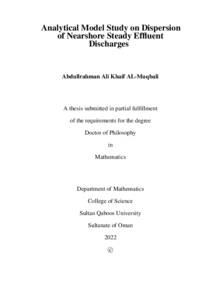Document
Analytical model study on dispersion of nearshore steady effluent discharges.
Publisher
Sultan Qaboos University.
Gregorian
2022
Language
English
English abstract
There are many types of marine outfall systems operated along the Omani coasts to discharge (treated) municipal wastewaters, cooling waters, or desalination brine effluents
to the Oman Sea. The outfall's system varies from a simple open channel at the shoreline, a short single port outfall and to modern long multiport diffusers. Discharged
effluents are primarily seawater but at a more concentrated level and warmer, and may
also contain some unknown chemical components which are subject to significant loss
due to temporal decay that varies with water depth.
Due to the complexity and uncertainty in sea conditions, mathematical models have
been widely applied to study dispersion and spreading of discharged effluent in coastal
waters, and to assess the potential environmental impacts of steady effluent discharge
from sea outfalls. In the far-field where the effluent plume is observed drifting away
with the currents, seabed depth profiles play an important role since in deeper water the
current tends to be faster, mixing is stronger, and there is a greater depth over which to
dilute the effluents. For nearshore discharges in particular, due to relatively weak cur rent and shallow water depth, the effluent plumes are observed to be spreading along the shoreline and cause a build-up of concentration to higher levels.
The analytical solutions of two-dimensional advection-diffusion equation with multiple sources in a continuous and discontinuous seabed depth profiles are presented to
investigate the effect of variability of water depth and decay. To replicate the merging
overlapping process of discharged effluent plumes in coastal waters, the solutions are
illustrated graphically by plotting contours. The concentration at the shoreline and at
the discontinuity line are formulated and used as a measure for assessing the impacts
of nearshore steady effluent discharge.
Member of
Resource URL
Arabic abstract
هناك العديد من أنواع أنظمة المصبات البحرية التي تعمل على طول السواحل العمانية لتصريف (معالجة) مياه الصرف الصحي البلدية أو مياه التبريد أو تحلية المياه المالحة.بحر عمان. يختلف نظام المصب من قناة مفتوحة بسيطة على الخط الساحلي ، ومنبع قصير بمنفذ واحد ، وناشر حديث متعدد المنافذ. مفرغ النفايات السائلة هي مياه البحر في المقام الأول ولكن على مستوى أكثر تركيزا ودفئا ، وربما تحتوي أيضًا على بعض المكونات الكيميائية غير المعروفة والتي تتعرض لخسارة كبيرة بسبب الانحلال الزمني الذي يختلف باختلاف عمق الماء.
Category
Theses and Dissertations

